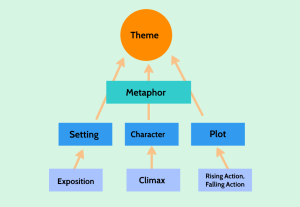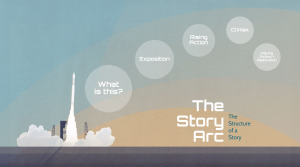5 The Story Arc
Learning Objectives
-
Consider how the narrative arc of a story affects pacing, plot development, tension, and characters’ choices.
-
Evaluate arguments in a text, including the validity of the reasoning, and the relevance and sufficiency of the evidence.
Chapter & Discussion
This chapter includes a presentation that can be navigated in a classroom setting or independently. You can access the presentation via the link below.
The Story Arc: The Structure of a Story
Work through the different sections of the chapter and discuss ideas and topics as they arise. If you’re working independently, take notes instead. Notes and active discussion will be helpful in navigating this week’s assignments.
What is the Story Arc?
1. The story arc is a small collection of vocabulary words that help readers figure out where there are in a story.
2. Over time, the story gets more (and less) intense. The story arc also measures that intensity over time.
Both of these functions can be useful in reflecting on a story and discussing it.
Tension is important to understanding the concept of the story arc. Essentially, narrative tension is the suspense of not knowing what happens next in a story. It’s what sustains the reader’s interest and keeps them turning pages. Narrative tension comes in many different forms, such as a relationship, a task, a mystery, or some kind of surprise.
Typically, it has to do with the consequences our characters may face if things go wrong.
How does the Story Arc help to communicate themes?
Like passages, the story arc reinforces elements of the setting, characters, and plot.
These elements are already helping author’s communicate themes, because they serve as metaphors for the author’s ideas.

Parts of the Story Arc
Exposition
- Background information
- This establishes what we need to know to understand the big picture
- It also plants narrative seeds which can “bloom” later in the story
Rising Action
- Once conflict is established, the rising action begin
- At this point, there is tension in the story
- This helps us understand characters’ intentions and the obstacles that stand in their way
- And more importantly, what choices they make to try to overcome those obstacles
Climax
- The height of the action, aka breaking point, boiling point, or turning point
- In every story, something’s gotta’ give. This is when it does.
- In the climax, a character (usually the protagonist) will make a choice that will determine the outcome
Falling Action and Resolution
- Falling action gives the audience the chance to recover from the intensity of the climax
- Resolution ties up any loose ends

Assigned Reading
Here are this week’s readings. Additionally, please read for your own personal enjoyment for 1/2 hour each day. This will be called your “Reading Zone” reading and it will coincide with many upcoming activities.
What is a Narrative Arc? by David Turkel (via Oregon State University)
Practice Set: The Story Arc
Click here to complete a practice set that explores concepts from the chapter.
These practice sets are designed to resemble the types of questions you’ll encounter on the GED RLA test. In this case, I am including a full novel chapter so that the reading can be engaging and so that you can have meaningful practice in the skill of close reading.
All of the practice sets in the Literature Unit will take on this format so that you can engage in enough practice to level up your reading skills while having access to literature that’s worth your time.
Assignment: Identifying the Story Arc (250 Words)
Select one of the Short Films to Teach Story Elements that you haven’t discussed yet. In a 250-word response, answer the following prompts:
-
Explain each milestone of the story arc as it appears in this short film.
-
In one of these milestones, is there storytelling that makes the theme clear? Discuss.
-
Does a character’s choice determine the final outcome? Explain.
Assignment: Reading Zone Response (250 Words)
For Reading Zone, you must find a novel that is interesting to you and enjoyable to read. If you need help finding a Reading Zone book, please ask. Please read your Reading Zone book for a half-hour each day. On class days, there will be time in class dedicated to reading.
Create a response to this week’s reading that addresses the following prompts:
-
In one paragraph, summarize what you’ve read this week
-
In a second paragraph, briefly explain each milestone of the story arc as it appears in this story. If you aren’t very far in, that’s okay. Just go as far as you’ve reached.


